 |
|
Case 8: Implements of Leisure |
Crochet Hooks Lent by Nancy NehringCrochet Hook Tray 1 Crochet became popular as a needle art in the 1840s. The earliest crochet hooks had removable needles. Crochet needles were made in Redditch, England, using the same techniques used to make sewing needles and fishing hooks. The needles were handmade of wrought iron and then the iron was converted to steel. Only a final polishing of the very hard steel was required. The first three crochet hooks are from 1847-1860. The first two were produced by G. Chambers and registered with the British patent office in 1847 and 1848 respectively. The hooks are steel, the mounts are brass (which was much easier to work than iron or steel) and the handles are bone. The first and third hooks have hollow handles in which to store extra hooks in varying sizes. The middle hook was probably part of a cased set with additional hooks stored in the case. An upper class woman in the last half of the nineteenth century displayed her status in several ways. One way was to engage in fine needlework. If she chose crochet, this meant working intricate lace patterns in fine threads. Most of the crochet hooks from this time period had fine steel hooks. A second way to display one's wealth was to have expensive needlework tools to use (and to show off) when one went visiting. Examples are: brass ormolu set with aquamarines possibly Indian, porcupine quill mounted in silver possibly Indian, brass with reversible steel hook that could be stored in body when not in use, glass paperweight with brass wire decoration possibly Murano glass from Italy, agate handle with brass mount. 1860-1880. Written by Nancy Nehring |
|
|
|
Crochet Hook Tray 2 Middle-class women had increasing amounts of discretionary time during this period. Lace was still a status symbol and making your own added beauty and status to your home and garments. Crochet was the fastest way to make lace, easy to learn, and the tools and thread inexpensive. This style of crochet hook was aimed at the middle-class market. The needles are steel and the handles are iron wire painted black to prevent rust. The needle and handle are held together with a brass mount. Most bear British patent marks for 1868-1883.Written by Nancy Nehring |
|
|
|
Crochet Hook Tray 3 Another style of crochet hook had the needle mounted in a flat brass handle. A groove in the handle allowed the hook to be retracted when not in use. The bottom two hooks have 2 and 4 needles mounted in a single handle. 1870-1900.Written by Nancy Nehring |
|
|
|
Crochet Hook Tray 4 About 1860, the Bessemer process for steel making was being developed. Steel could now be made in large vats. Steam powered machinery could draw steel into wires or sheets and manipulate steel into more complex shapes. The first three hooks have tubular steel handles. Brass was still easier to work into complex shapes than steel so the needle is still mounted in the handle with brass. The next three hooks use wrapped steel wire to form the handles. Larger steel hooks could now be made. The Tartanware hook was sold as a souvenir. The Climax hook, made by the same company, uses a stamped steel handle. The bottom four examples each contain three hooks of differing sizes mounted in a handle. The sheath is removed, the desired hook selected, and the sheath replaced. The first two examples have brass and silver sheaths. The last two have painted steel sheaths. Transfer lithography used on steel became popular about 1870. This painted sheath style as manufactured until about 1930. 1860-1880.Written by Nancy Nehring |
|
|
|
Crochet Hook Tray 5 Large hooks for wool work were not common. Wool crocheted garments were a novelty, most wool garments were knitted. Large hooks for middle class use were made of wood or bone. A few hooks were made of fancier materials and many of these had fine hooks for lace work. The top two are made from ivory 1850-1880. One has a large hook for wool and one a fine hook for lace. The next is made of horn inlaid with silver wire and mother of pearl 1870. The next two are hand-carved bone. The hand motifs on the ends and the painted patterns were popular about 1865. The bottom two hooks are lathe-turned bone. These were inexpensive hooks made from cow shinbone. They were made and used for over 100 years from the 1840s until the mid-1960s.Written by Nancy Nehring |
|
|
Other Implements
Miss Lambert's description: "It is used for stretching knitted, netted, and crochet purses. The purse, when finished, before the ends are drawn together, should be sewn up at the mouth, and passed over the wooden cylinder; as represented above; it should then be slightly damped, and the screws tightened, taking care not to strain it too much. By this simple process, the stitches become more firmly fixed in their relative positions, and the purse assumes, and afterwards retains, its proper shape." |
|
|
|
Miss Lambert's description: "The above engraving represents two kinds of purse moulds, of wood or ivory, on which short purses are worked. The one called a moule Turc, has small brass pins fixed round the edges of its largest circumference. A purse may be made on this mould by fixing the silk by a loop over one peg, and twisting the silk separately round each of the others,-the silk being held in the right hand. When this first row is done, wind the silk once again round the peg with the loop, and with a steel point or needle pass the first stitch over the second, and continue the same over each peg as each successive stitch is made, and so on, row after row, until the purse becomes of a sufficient length &On the other mould or cup, a very pretty bourse en festoon may be made, either with two coloured silks, or silk and gold. Since the introduction of crochet, however, these moulds have not been much used." |
|
|
|
Miss Lambert describes the filiere, or gauge, "as a steel instrument with graduated notches round its edges, distinguished by different figures. It is used by wire-drawers for ascertaining the sizes of their wires, and is applied in a similar manner, for measuring the diameters of netting and knitting needles; thus -- when speaking of the relative size of these needles, they are frequently designated by their corresponding numbers; but, as has been before observed, there appears to be no universal standard." |
|
|
|
"Crochet Basket for Reel of Cotton." Godey's Lady's Book and Magazine. August 1869. Godey's provides the following description for the basket: "This basket is meant to hold the cotton whilst working, so as to keep it clean to the end of the work. The cover of the basket has a hole in the middle, through which the end of the cotton is drawn. Our pattern imitates the straw basket; it is worked [in crochet] with yellow and brown purse silk over straw braid." |
|
|
|
"Knitting Basket." Godey's Lady's Book and Magazine. December 1869. Made from six cardboard panels lined with white silk, this knitting basket is embellished with appliquéd stars and red braid. |
|
|
|
"Case for Knitting or Crochet Needles." Godey's Lady's Book and Magazine. July 1867. Godey's provides the following description for the case: "This convenient little article is formed of a sheet of perforated card slit at intervals to admit a narrow velvet or ribbon being passed through to form a checkered pattern, as seen in Fig. 1. The white blocks are then crossed with zephyr, or chenille, matching the ribbon in shade. The case is edged round with a quilled velvet, and finished with buttons and elastic bands, as represented in Fig. 2. The inside, which is represented in Fig. 3., is lined with cashmere or flannel, and furnished with small sheaths of kid or leather, having the numbers of the needles embroidered on them. The small cross flaps may be of leather or velvet, finished on the edge in button-hole stitch." |
|
|
Knitting Implements
Knitting Needle Sheath (Heart). Silver. 1790-1820. Lent by the Winterthur Museum. Knitting Sheath. Wool, quill, and glass. 1790-1825. Lent by the Winterthur Museum. A woman would pin these small devices in an upright position to the waist of her skirt when knitting. By placing a knitting needle in the slender tube and manipulating it against another hand held needle, she freed one of her hands for other related purposes. |
|
|
|
Knitting Needle Case. Silver. 1791-1818. Lent by the Winterthur Museum.
Knitting Needles. Nineteenth Century. Lent by the Winterthur Museum. |
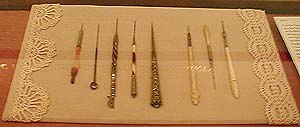
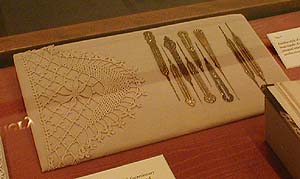


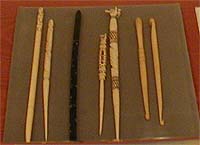
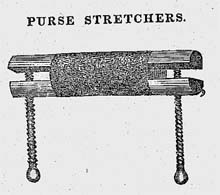 "Purse
Stretchers." Miss F. [Frances] Lambert. The Hand-book of Needlework.
New York: Wiley & Putnam, 1842.
"Purse
Stretchers." Miss F. [Frances] Lambert. The Hand-book of Needlework.
New York: Wiley & Putnam, 1842. 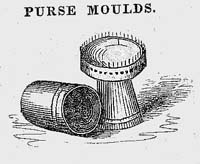 "Purse
Moulds." Miss F. [Frances] Lambert. The Hand-book of Needlework.
New York: Wiley & Putnam, 1842.
"Purse
Moulds." Miss F. [Frances] Lambert. The Hand-book of Needlework.
New York: Wiley & Putnam, 1842. 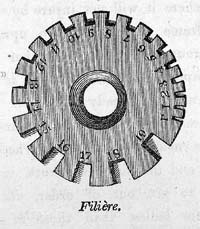 "Filiere."
Miss F. [Frances] Lambert. The Hand-book of Needlework. New York:
Wiley & Putnam, 1842.
"Filiere."
Miss F. [Frances] Lambert. The Hand-book of Needlework. New York:
Wiley & Putnam, 1842.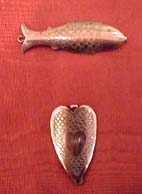 Knitting
Needle Holder (Fish). Silver. Ca. 1800. Lent by the Winterthur Museum,
Bequest of Henry Francis du Pont.
Knitting
Needle Holder (Fish). Silver. Ca. 1800. Lent by the Winterthur Museum,
Bequest of Henry Francis du Pont.